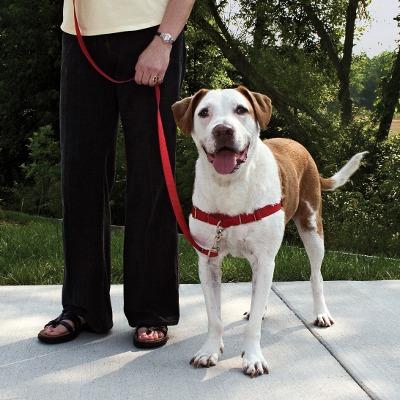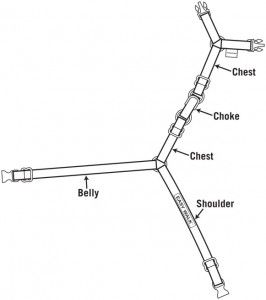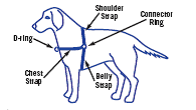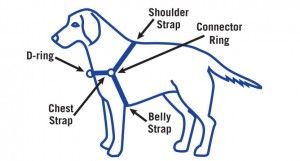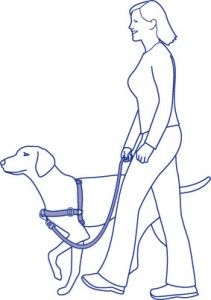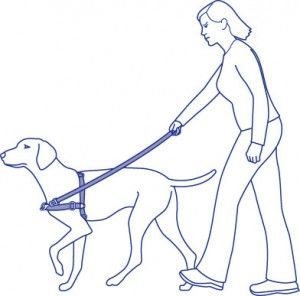By Michelle Mullins with contributions by Nicole Backus
On a visit to Alaska a few years ago, I visited Happy Trails Kennelshttp://buserdog.com/, the home of Martin Buser and his amazing sled dogs. Martin is a 4 time Iditarod Champion and 4 time winner of the Leonhard Seppala Award for the most humanitarian care of his dogs. These dogs are simply amazing at doing what they do which is-PULL!
Martin and Michelle
Martin Buser
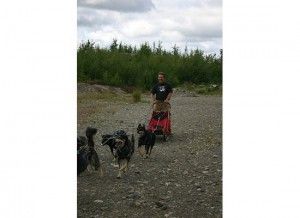
That is great if you want a champion sled dog but not so great if you just want to walk your pup around the neighborhood. Another important thing I learned about sled dogs is how important their equipment is, including the harnesses they wear.
Proper fit is a must. The same is true for our Easy Walk Harness! A proper fit is essential for comfort and use. I see lots of dogs wearing this popular harness and enjoying walks with their people. However sometimes I stop and and introduce myself hoping to get a chance to adjust the harness for a better fit.
When the Easy Walk comes out of the package you might be a bit perplexed as it fits very different than a standard harness but it isn’t as complicated as you might think at first.
Follow the instructions and tips and you can be taking a lovely stroll with your dog in no time instead of out for another Iditarod training session!
Michelle and the future Iditarod Champions
Before you get started
Step 1: Fit the Shoulder strap
Step 2: Fit the Belly strap Once the shoulder and belly straps have been connected and adjusted they should….
Step 3: Fit the Chest strap
When fit properly the harness should resemble a sideways T, as much as possible. However, we understand that like humans, dogs have different body shapes and that the harness may not fit exactly like this on every dog.
If the harness looks like a sideways Y as below, the fit is not correct. This will cut into the dogs arm pits
Finally you are ready to attach the leash to the D-ring on the chest strap and go for a walk!
Although the harness may have an immediate change in your dog’s pulling habits and it may feel more manageable to walk your dog, he may still pull while wearing it. The harness is designed to redirect your dog from pulling and help achieve loose leash walking.
The harness helps you achieve the behavior so you can reward the dog for walking beside you. Use the tension on the leash to guide you and your dog. No tension and a loose leash equals = “YES!” and the walk continues.
This is the moment to reward your dog with a small treat and praise.
Tension and tight leash = “Incorrect” and you should gently redirect the dog back into position beside you.
As soon as you feel tension on the leash, redirect your dog’s attention to you; you may need to slow down or stop.
Once he is back in the desired heeling position, we suggest rewarding* your dog with a treat before you start walking again. You may find yourself redirecting your dog quite a bit in the beginning, but with some patience, consistency, and rewards such as their favorite treat, he will quickly learn the easy way to walk with you.
Training your dog to walk politely beside you can take a little work but can be fun and will be well worth the effort. The easy Walk Harness will help you get there! Instead of having a sled dog wanna be, you can instead enjoy following the Iditarod that starts on March 3rd. Martin Buser will be there for his 29th consecutive start!
- Identify the straps of your harness
- Start with all straps fully extended
- Open the quick-snap buckle on the belly strap and place the shoulder strap over the dog’s head with the chest strap resting on the dog’s chest.
- Adjust the shoulder strap so that the connector rings sits above and behind the dog’s shoulder (See figure 1)
- Connect the belly strap quick-snap buckle. Tighten the belly strap to a comfortably, snug fit.
- Resemble a vertical line – as much as possible and should not be in the dogs sensitive armpit area.
- Have a snug fit – so “snug” that only a finger width can get between the nylon strap and the dog’s fur. A snug fit is important because the girth straps (shoulder and belly straps combined) create the “foundation” that keeps the harness in place, preventing the straps from moving against the dog’s fur.
- AFTER you have the girth straps properly secured, you can begin to fit the chest strap. Gently press your fingers on the lower front of the dog’s chest to locate the breastbone.
- Adjust each portion of the chest strap equally to keep the D-ring centered.
- When adjusted correctly, the chest strap will be horizontal, resting over the dog’s breastbone. The strap should not hang down, gap, or choke the dog. If this happens, you may require a different size.

